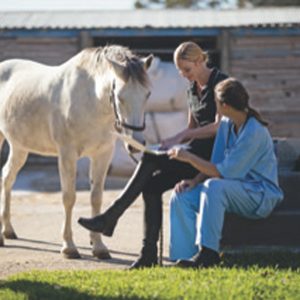
Vitamin E: testing, understanding results, and determining supplementation levels in horses
When should I test my horse’s vitamin E levels?
If you are seeing any of the following signs of vitamin E deficiency, it is a good idea to talk to your vet about testing.
- Lack of energy or sour attitude
- Stiff before and sore after exercise
- Anxiety when being trained or ridden
- Poorly developed topline
- Abnormal neurological exam
- Evidence of muscle myopathy
- Poor immune response
What is a normal level of vitamin E found in the blood?
Depending on what lab your vet uses to have your blood sample analyzed, your results can be recorded using one of two units.
Testing units:
– ug/mL (micrograms per milliliter)
The range for ug/mL is 1 to 10.
– ug/dL (micrograms per deciliter)
The range for ug/dL is 100 to 1,000.
Understanding the results:
- Normal is considered above 2 ug/mL (200 ug/dL).
- Marginally deficient is 1.5 ug/mL (150 ug/dL).
- Severely deficient is 1 ug/mL (100 ug/dL) or below.
- Recommended range for the average performance horse is 3 ug/mL to 5 ug/mL (300 ug/dL to 500 ug/dL).
It is best to keep blood levels below 10 ug/mL (1,000 ug/dL). Levels above that are not beneficial to the horse.
There has been no toxic level of vitamin E established in horses.
When should I retest vitamin E levels?
It is best to work with your veterinarian to determine when retesting is needed. If you supplement with Elevate® W.S., which is fast acting and will begin to raise levels immediately, then you can test sooner than if you are using Elevate® Powder. Elevate Powder takes 3 to 5 weeks to significantly impact levels.
Should I test my horses annually?
You can test annually as part of your wellness exam, but if your horse is adequately supplemented and isn’t show any symptoms of Vitamin E deficiency, it isn’t necessary.
What levels of vitamin E supplementation should I give my horse?
Different horses doing different jobs need different amounts of vitamin E. Don’t over-supplement your horse. Take into consideration other sources of natural vitamin E that may be part of your horse’s diet, such as fortified grains, balancer pellets or vitamin/mineral supplements. If you can’t tell if the vitamin E in a feed or supplement is natural, contact the manufacturer and ask.
Know the difference between synthetic vitamin E (noted as dl-alpha-tocopherol or vitamin E supplement) and natural vitamin E (noted as d-alpha-tocopherol or natural vitamin E). Synthetic vitamin E is poorly absorbed and utilized by horses and is of little benefit unless fed in very large quantities.
Recommended supplementation levels of natural vitamin E per day:
Note: Your veterinarian may recommend more or less, depending on your horse’s individual needs.
- Horses on full-time, good quality pasture in no work to light work: 1,000 IU in the winter only.
- Horses on full-time, good quality pasture in medium to heavy work: 1,000 IU to 2,000 IU depending on workload.
- Horses without access to pasture or on limited turnout, at maintenance or in light work: 1,000 IU to 2,000 IU.
- Horses without access to pasture or on limited turnout in medium to heavy work: 2,000 IU to 5,000 IU.
- Pregnant or nursing mares, regardless of turnout status: 3,000 IU.
- Foals: 3,000 IU.
- Horses with muscle myopathy or neurological disease may require 6,000 IU to 10,000 IU per day. Please consult with the treating veterinarian before supplementing at these levels. Severity of symptoms and current vitamin E status will inform supplementation levels.


